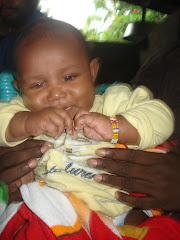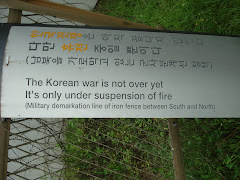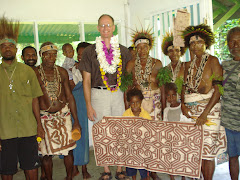Wednesday, August 5, 2015
Visit to Papua New Guinea
I have been in Papua New Guinea from July 6 until August 4, a bare month. But what a month!
I started in Port Moresby, sharing the floor of St. Francis Church sacristy with Br. Oswald. He had fixed a pallet next to his with new sheets and mosquito net. The sacristy is a very narrow space: fortunately neither of us snore. What made it bearable was watching the construction of the new St. Francis School and parish mission house which is going up lickety-split, prefab structures on concrete slabs. The new construction is about 25 years overdue. I used to hate, hate, hate staying in the old mission house. We created a tiny friary, saying our offices hunkered on the floor, boiling the tea kettle on the floor between out beds for morning tea. Some youths who lived in an old classroom beneath Oswald’s sacristy built campfires to cook dinner, using construction rubbish. Dinners were huge, thank God.
I spent the days jogging, scrambling around Port Moresby with Oswald, gaping at all the frenzied construction that was going on in preparation for the Pacific XV Games—never mind they were half way through with the games! It’s going to be nice for residents of Port Moresby. But the rest of the country, as brothers and other pundits were saying still lacks very basic services, and these building projects for sports fill the hearts of a predominantly rural people longing for sanitation, education, healthcare with a deep ambivalence.
Then over the Stanley Range to Popondetta for Provincial Chapter. The Archbishop Clyde Igara, who is also the Provincial Bishop Protector gave a hard hitting workshop on leadership. Actually is was three hours straight of listening to him while sitting in very hard benches. But the brothers seemed riveted. Now we wait for the proof of the pudding…
The meetings were as meetings are: entertaining, dull, helpful, obstructionist, too long, not enough time. Normal meetings. The best part was being with the brothers and enjoying their humor and ways of being as men from Papua New Guinea. There is a bluntness in their conversation that leaves me breathless sometimes. During meeting breaks they all swarm about scavenging betel nuts to chew. I love the spicey smell, but not the red/black teeth. My AA sponsor long ago warned me off the stuff too because of the prized dizzy sensation and sudden loquaciousness.
My special pleasure was the cross country runs. I went several times. Once alone, and the following ties I was joined by some brothers and youths who are living in a Federal Detention Center located at the friary. Though it is surrounded by razor wire it is never locked that I could tell, the boys come to chapel, and meals with the brothers. Mostly they are 15-16 year olds who have gotten into fights after drinking or caught doing drugs, petty larceny. Remove the substances and the peer cliques and you have really nice boys! They latched onto me, and we all loved racing the roads. Once 8 of us went out, brothers lagging to the back to be sure the boys didn’t slip away, out numbers were swelled by several neighbor boys who came along.
After Chapter I flew to Milne Bay Province, to Alotau. The brother’s friary is in a village called Ukaka, which is the name of a tree. We visited some Solomon Island Sisters of the Church studying evangelism at Hagita (which is the name of an enormous snake species that lives near there—I didn’t see one, thank God). We chattered away in Solomon Pijin, crunching the incredibly hard navy biscuits and drinking tea. I’ve known these two sisters, Phyllis and Agnes for nearly 20 years, so it was really old home week.
One day the brothers took me to a cultural day at Cameron High School. The students were grouped according to their province of origin, and they learned and performed the appropriate cultural customs of their local people. The day we visited they were enacting the rituals for presenting food offerings for a feast. These are strikingly varied. The brothers were all from Oro Province so we were sitting in the Oro shelter. Girls in tapa skirts and wraps, boys in tapa loincloths with kundu drums did the province proud with the Butterfly dance. I have been welcomed to the friary with this dance before, it is extraordinary. The poor pig shit himself when they hoisted it up on a stout pole to carry to the other side of the exhibition grounds with loud shouts and ululations. Then he got axed. Must have known it was coming.
The most electrifying performance was from the Manus people who were wearing bright read loin cloths (“Not traditional,” one Oro man sniped). I thought they were lovely. The boys marched onto the field with very large yams with which they did all kinds of lascivious things, thrusting their pelvis and pumping the yams up and down, held like footballs in front of them. I thought that took the cake for eye popping food sex. It was a great crowd pleaser. But then the crowd began to roar and laugh, and we all pressed against the police line that was trying to keep order. Several of the boys had emerged from a scrum wearing very long phalluses hanging from the fold of their red wraps, like the prominent stamens of the hibiscus flower. They had adorned the ends of these monsters with large cowry shells, and in ecstasy they whirled around flinging their appendages at each other, advancing on the crowd, grabbing each other. Adolescent heaven, and every single person there got the message about the life giving nature of the yam and its importance to the survival of the people.
Pigs squealed behind the dancers, suddenly there was extremely loud drumming and chicken carcasses were flung up into the air, the crowd started pressing harder together, then another pig got axed.
All this time rain slashed down, mud up to our ankles. These thousand year old customs protect something precious about community life, custom, survival and the power of art that is so missing from much of modern life. It sure trumped canapés and dinner parties!
I started in Port Moresby, sharing the floor of St. Francis Church sacristy with Br. Oswald. He had fixed a pallet next to his with new sheets and mosquito net. The sacristy is a very narrow space: fortunately neither of us snore. What made it bearable was watching the construction of the new St. Francis School and parish mission house which is going up lickety-split, prefab structures on concrete slabs. The new construction is about 25 years overdue. I used to hate, hate, hate staying in the old mission house. We created a tiny friary, saying our offices hunkered on the floor, boiling the tea kettle on the floor between out beds for morning tea. Some youths who lived in an old classroom beneath Oswald’s sacristy built campfires to cook dinner, using construction rubbish. Dinners were huge, thank God.
I spent the days jogging, scrambling around Port Moresby with Oswald, gaping at all the frenzied construction that was going on in preparation for the Pacific XV Games—never mind they were half way through with the games! It’s going to be nice for residents of Port Moresby. But the rest of the country, as brothers and other pundits were saying still lacks very basic services, and these building projects for sports fill the hearts of a predominantly rural people longing for sanitation, education, healthcare with a deep ambivalence.
Then over the Stanley Range to Popondetta for Provincial Chapter. The Archbishop Clyde Igara, who is also the Provincial Bishop Protector gave a hard hitting workshop on leadership. Actually is was three hours straight of listening to him while sitting in very hard benches. But the brothers seemed riveted. Now we wait for the proof of the pudding…
The meetings were as meetings are: entertaining, dull, helpful, obstructionist, too long, not enough time. Normal meetings. The best part was being with the brothers and enjoying their humor and ways of being as men from Papua New Guinea. There is a bluntness in their conversation that leaves me breathless sometimes. During meeting breaks they all swarm about scavenging betel nuts to chew. I love the spicey smell, but not the red/black teeth. My AA sponsor long ago warned me off the stuff too because of the prized dizzy sensation and sudden loquaciousness.
My special pleasure was the cross country runs. I went several times. Once alone, and the following ties I was joined by some brothers and youths who are living in a Federal Detention Center located at the friary. Though it is surrounded by razor wire it is never locked that I could tell, the boys come to chapel, and meals with the brothers. Mostly they are 15-16 year olds who have gotten into fights after drinking or caught doing drugs, petty larceny. Remove the substances and the peer cliques and you have really nice boys! They latched onto me, and we all loved racing the roads. Once 8 of us went out, brothers lagging to the back to be sure the boys didn’t slip away, out numbers were swelled by several neighbor boys who came along.
After Chapter I flew to Milne Bay Province, to Alotau. The brother’s friary is in a village called Ukaka, which is the name of a tree. We visited some Solomon Island Sisters of the Church studying evangelism at Hagita (which is the name of an enormous snake species that lives near there—I didn’t see one, thank God). We chattered away in Solomon Pijin, crunching the incredibly hard navy biscuits and drinking tea. I’ve known these two sisters, Phyllis and Agnes for nearly 20 years, so it was really old home week.
One day the brothers took me to a cultural day at Cameron High School. The students were grouped according to their province of origin, and they learned and performed the appropriate cultural customs of their local people. The day we visited they were enacting the rituals for presenting food offerings for a feast. These are strikingly varied. The brothers were all from Oro Province so we were sitting in the Oro shelter. Girls in tapa skirts and wraps, boys in tapa loincloths with kundu drums did the province proud with the Butterfly dance. I have been welcomed to the friary with this dance before, it is extraordinary. The poor pig shit himself when they hoisted it up on a stout pole to carry to the other side of the exhibition grounds with loud shouts and ululations. Then he got axed. Must have known it was coming.
The most electrifying performance was from the Manus people who were wearing bright read loin cloths (“Not traditional,” one Oro man sniped). I thought they were lovely. The boys marched onto the field with very large yams with which they did all kinds of lascivious things, thrusting their pelvis and pumping the yams up and down, held like footballs in front of them. I thought that took the cake for eye popping food sex. It was a great crowd pleaser. But then the crowd began to roar and laugh, and we all pressed against the police line that was trying to keep order. Several of the boys had emerged from a scrum wearing very long phalluses hanging from the fold of their red wraps, like the prominent stamens of the hibiscus flower. They had adorned the ends of these monsters with large cowry shells, and in ecstasy they whirled around flinging their appendages at each other, advancing on the crowd, grabbing each other. Adolescent heaven, and every single person there got the message about the life giving nature of the yam and its importance to the survival of the people.
Pigs squealed behind the dancers, suddenly there was extremely loud drumming and chicken carcasses were flung up into the air, the crowd started pressing harder together, then another pig got axed.
All this time rain slashed down, mud up to our ankles. These thousand year old customs protect something precious about community life, custom, survival and the power of art that is so missing from much of modern life. It sure trumped canapés and dinner parties!
Subscribe to:
Post Comments (Atom)






No comments:
Post a Comment